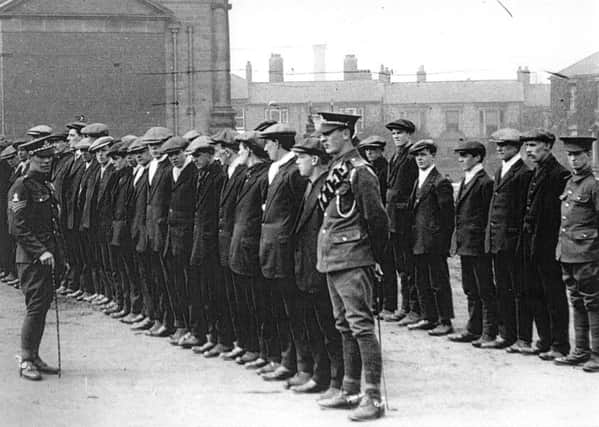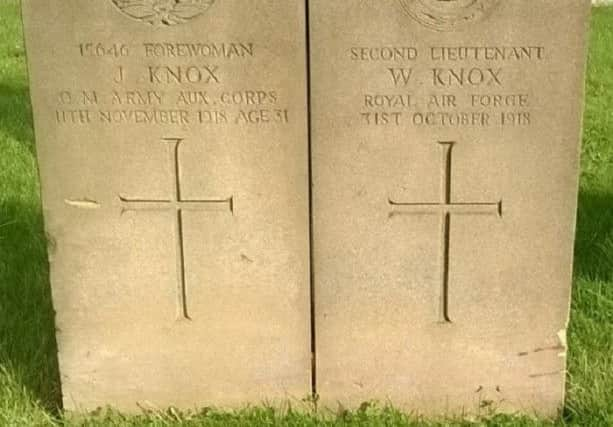South Shields family suffers double tragedy within days


“On November 11, 1918, in number 17 Hunter’s Terrace, South Shields, the home of the Knox family, Armistice Day must have been subdued,” said Dorothy.
“That’s because they were mourning the death of their youngest son, Second Lieutenant William Knox, of the Royal Flying Corps, who had been killed, aged just 19 – 11 days before.


Advertisement
Hide AdAdvertisement
Hide Ad“On that joyous, noisy day for the townsfolk of Shields they were also given the cruel news that that very day, their daughter Jane, serving in the Women’s Army Auxiliary Corps, had also died whilst serving her country. There was little cause for celebration in their household that day.”
Parents George Wallace and Isabella Knox had seven children, Alan, John, George, Albert, Isabel, William and Jane, all of whom were born in South Shields.
Seven years earlier, Jane Knox was working as a general domestic servant for the family of George Pritchard, a steamship manager, before joining the Women’s Army Auxilliary Corps (WAAC).
The WAAC had been formed in December 1916, although its forerunner was the Women’s Legion, which was started in 1915 by Lady Londonderry.
Advertisement
Hide AdAdvertisement
Hide AdA War Office investigation at the time, showed that a large number of non-combatant tasks were being performed by soldiers in France.
“It was obvious,” says Dorothy, “that women could do many of these jobs and free up 12,000 men for frontline service.
“The first women recruits arrived on the Western Front on March 31, 1917, and eventually their numbers there rose to 9,000.
“By April of 1918, the WAAC had been renamed Queen Mary’s Army Auxiliary Corps, with 57,000 women serving.
Advertisement
Hide AdAdvertisement
Hide Ad“They wore khaki uniforms which consisted of a small cap and a jacket and a skirt, which had to be no more than 12 inches off the ground.
“They were issued a pair of heavy, cumbersome shoes, two khaki overalls, two pairs of woollen stockings, but had to provide their own underwear.
“The women had to keep fit, just like the soldiers, and they too were housed in primitive Nissan huts.
“In France, a large number of these women were clerks and typists, with a working day that lasted from nine in the morning until sometimes 10 or 11 in the evening.
Advertisement
Hide AdAdvertisement
Hide Ad“Some worked in the record office, in France, maintaining the service records of soldiers and for this they received 27s-6d to 31s-6d per week.
“Shorthand typists and forewomen clerks, were paid 37s-6d and from this 14s was deducted for board and lodging, however they were given free entry to all military amusements and concerts.
“Women were also signallers as telephonists and telegraphists.
“In this department much of the work was top secret and discretion was necessary.
Advertisement
Hide AdAdvertisement
Hide Ad“This year marks the 100th anniversary since British women, over the age of 30, were given the vote and those remarkable women – performing male roles for the first time in the British Army – certainly helped that cause.”
Dorothy goes on to explain that Jane’s service record no longer exists, having been destroyed in a bombing raid during the Second World War.
“However, it is known that she enlisted in South Shields, that her army number was 15646, and that she was first stationed in East Denham, where funnily enough, her brother William began his pilot training (see Thursday’s tribute page).
“Her death entry refers to her in Royal Engineers Chatham at that time, which is possibly an indication she was a forewoman signaller. It is known that these women worked alongside the Royal Engineers, doing 12-hour shifts as signallers.
Advertisement
Hide AdAdvertisement
Hide Ad“It’s very possible she was wounded working in signals with the Royal Engineers in France, during a bombing raid and died later of wounds in England.
“What is known is her death occurred on November 11, 1918 at St Mary’s Barracks, Chatham, and her effects would have been returned to her parents.
“She was buried in a military grave in Harton Cemetery with her brother William, their two headstones being joined.”
l On Thursday, Dorothy tells how Jane’s brother, William, tried to “trick” his way into joining the war effort and how he became another casualty of this most terrible of conflicts.